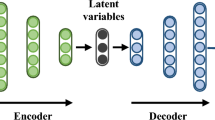Abstract
Real-world problems are addressed effectively and safely using simulation modeling. Simulation modeling gives highly appreciable solutions by providing a clear picture of complex systems. The reason for the same is that nonlinear structure of real-world problems with complexities cannot be handled by linearized models. Further, computational complexities of large-scale dynamical system simulations occurring in such situations will be reduced by model order reduction (MOR). This is further improved with the use of artificial neural networks (ANNs). In this paper, the generalized neural network modeling of nonlinear autonomous dissipative system using machine learning and proper orthogonal decomposition (POD) has been addressed, which is a novel one. The fluid mechanical model considered here is trained with multiple temporal swatches evolved on different parametric variations and trialed out at different time instances. Machine learning tries to learn such models by analyzing snapshot observations from active systems. The neural network developed by machine learning is able to make better prediction for validating data which is different from the training data set. The complexity of the data set generated by nonlinear autonomous dissipative system is reduced by applying the POD on the original data set. This demonstrates that the neural network is successfully utilized to macromodel the autonomous dynamical system.
Access this chapter
Tax calculation will be finalised at checkout
Purchases are for personal use only
Similar content being viewed by others
References
Antoulas AC (2004) Approximation of large-scale dynamical systems: an overview. IFAC Proc Vol 37(11):19–28; 10th IFAC/IFORS/IMACS/IFIP symposium on large scale systems 2004: theory and applications. Osaka, Japan
Bailer-Jones CA, MacKay DJ, Withers PJ (1998) A recurrent neural network for modelling dynamical systems. Netw Comput Neural Syst 9(4):531–547. PMID: 10221578
Chen S, Billings SA (1992) Neural networks for nonlinear dynamic system modelling and identification. Int J Control 56(2):319–346
Foresee FD, Hagan MT (1997) Gauss-newton approximation to bayesian learning. In: Proceedings of international conference on neural networks (ICNN’97), vol 3, pp 1930–1935
Demuth HB, Beale MH, De Jess O, Hagan MT (2014) Neural network design, 2nd edn. Martin Hagan, USA
Fang Y, Yagoub MC, Wang F, Zhang QJ (2000) A new macromodeling approach for nonlinear microwave circuits based on recurrent neural networks. IEEE Trans Microwave Theory Tech 48(12):2335–2344
Goodfellow I, Bengio Y, Courville A (2016) Deep learning. MIT Press
Henneron Thomas, Clenet Stephane (2014) Model order reduction of non-linear magnetostatic problems based on POD and DEI methods. IEEE Trans Mag 50(2):33–36
Kabir H, Yu M, Zhang QJ (2010) Recent advances of neural network-based EM-CAD. Int J RF Microwave Comput Aided Eng 20(5):502–511
Kanaan M, Khazaka R (2011) Model order reduction for nonlinear macromodeling of RF circuits. In: 2011 IEEE 9th International on new circuits and systems conference (NEWCAS). IEEE, pp 217–220
Kanaan M, Khazaka R (2017) Nonlinear time-domain macromodeling using proper orthogonal decomposition and feedforward neural networks. In: 30th Canadian conference on electrical and computer engineering (CCECE). IEEE, pp 1–4
Kerschen G, Golinval JC, Vakakis AF, Bergman LA (2005) The method of proper orthogonal decomposition for dynamical characterization and order reduction of mechanical systems: an overview. Nonlinear Dyn 41(1–3):147–169
Levenberg K (1944) A method for the solution of certain nonlinear problems in least squares. Q Appl Math 2(2):164–168
MacKay DJC (1991) Bayesian interpolation. Neural Comput 4:415–447
Marquardt D (1963) An algorithm for least-squares estimation of nonlinear parameters. J Soc Ind Appl Math 11(2):431–441
Nagaraj S, Seshachalam D (2018) Neural network macromodeling of nonlinear electrical circuit for variable frequency inputs using karhunen-loeve decomposition. In: Third IEEE international conference on computational systems and information technology for sustainable solutions (CSITSS-2018). Bengaluru, India
Nagaraj S, Seshachalam D, Hucharaddi S (2018) Model order reduction of nonlinear circuit using proper orthogonal decomposition and nonlinear autoregressive with exogenous input (narx) neural network. In: 2018 16th ACM/IEEE international conference on formal methods and models for system design (MEMOCODE), pp 1–4
Nguyen T, Schutt-Aine JE (2018) A pseudo-supervised machine learning approach to broadband lti macro-modeling. In: 2018 IEEE international symposium on electromagnetic compatibility and 2018 IEEE Asia-Pacific symposium on electromagnetic compatibility (EMC/APEMC), pp 1018–1021
Norgaard M, Ravn O, Poulsen NK, Hansen LK (2000) Neural networks for modelling and control of dynamic systems: a practitioner’s handbook, 1st edn. Springer, Berlin
Schilders WH, Van der Vorst HA, Rommes J (2008) Model order reduction: theory, research aspects and applications. Mathematics in industry. Springer, Germany
Striebel M, Rommes J (2018) Model order reduction of nonlinear systems: status, open issues, and applications
Widrow Bernard, Rumelhart David E, Lehr Michael A (1994) Neural networks: applications in industry, business and science. Commun. ACM 37:93–105
Wilson TG (1988) Life after the schematic: the impact of circuit operation on the physical realization of electronic power supplies. Proc IEEE 76(4):325–334
Zhang G, Patuwo BE, Hu MY (1998) Forecasting with artificial neural networks:: The state of the art. Int J Forecasting 14(1):35–62
Zhang QJ, Gupta KC, Devabhaktuni VK (2003) Artificial neural networks for rf and microwave design-from theory to practice. IEEE Trans Microwave Theory Tech 51(4):1339–1350
Author information
Authors and Affiliations
Corresponding author
Editor information
Editors and Affiliations
Rights and permissions
Copyright information
© 2023 The Author(s), under exclusive license to Springer Nature Singapore Pte Ltd.
About this paper
Cite this paper
Nagaraj, S., Seshachalam, D., Jayalatha, G. (2023). POD—ANN Reduced Order Macromodel of Nonlinear Autonomous Dissipative System Using Machine Learning. In: Srinivas, S., Satyanarayana, B., Prakash, J. (eds) Recent Advances in Applied Mathematics and Applications to the Dynamics of Fluid Flows. Lecture Notes in Mechanical Engineering. Springer, Singapore. https://doi.org/10.1007/978-981-19-1929-9_31
Download citation
DOI: https://doi.org/10.1007/978-981-19-1929-9_31
Published:
Publisher Name: Springer, Singapore
Print ISBN: 978-981-19-1928-2
Online ISBN: 978-981-19-1929-9
eBook Packages: EngineeringEngineering (R0)




